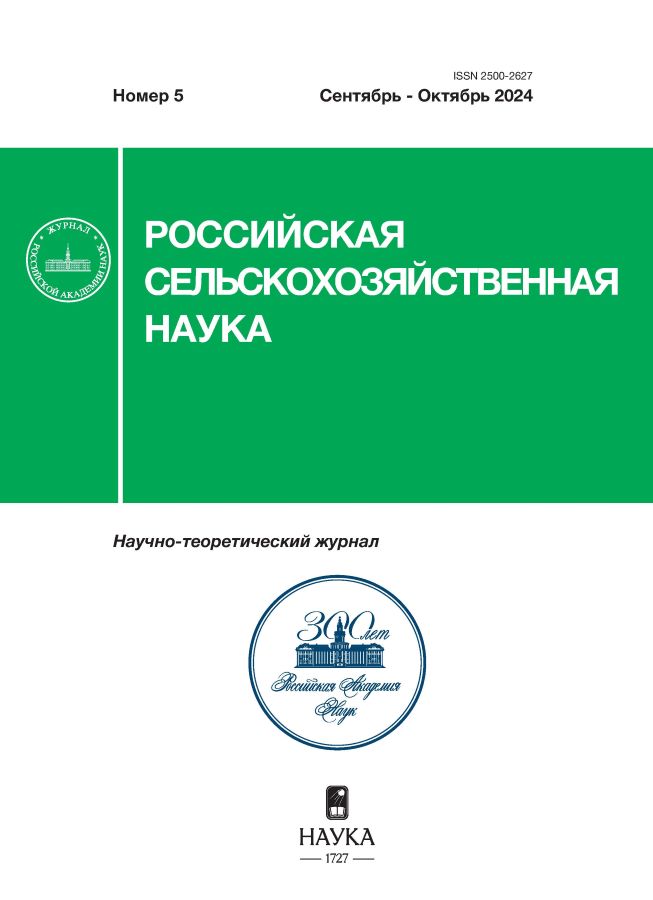Economic and biological features of sheep obtained from crossing the Edilbaev breed with a dorper
- Авторлар: Gorlov I.F.1, Slozhenkin M.I.1, Magomadov T.A.2, Yuldashbayeva A.Y.2, Shakhbazov O.P.3, Rajabov R.G.3
-
Мекемелер:
- Povolzhsky Research Institute for the Production and Processing of Meat and Dairy Products
- Russian State Agrarian University – K. A. Timiryazev Agricultural Academy
- Don State Agrarian University
- Шығарылым: № 5 (2024)
- Беттер: 41-44
- Бөлім: Animal science and veterinary medicine
- URL: https://journals.eco-vector.com/2500-2627/article/view/657940
- DOI: https://doi.org/10.31857/S250026272405008
- EDN: https://elibrary.ru/SIQKFY
- ID: 657940
Дәйексөз келтіру
Аннотация
The relevance of the work is due to the need to increase the efficiency of sheep farming in the southern regions of Russia to improve food security and increase the production of high-quality meat. The purpose of the study was to evaluate the effect of crossing Edilbaev sheep with dorper sheep on the productive and biochemical parameters of young animals in the southern regions of Russia. During the study, three groups of animals were formed: purebred sheep of the Edilbaev breed (control group), mixed young with an equal proportion of blood (½ Edilbaev × ½ dorper, the first group) and young with a greater proportion of blood dorper (¼ Edilbaev × ¾ dorper, the second group). The results showed that the young of the second group demonstrated the highest indicators in terms of live weight and improved biochemical characteristics. The live weight in this group was 10.3 % higher (p<0.05) compared to the control group. The total protein level in the second group was 110.89±10.86 g/l, which exceeded the indicators of the control group (105.68±5.33 g/l) by 4.9 % (p<0.05). It was also revealed that the serum calcium content in the second group exceeded the values of the first group by 84.3 % (p<0.001), which indicates an improvement in mineral metabolism. The analysis confirms that crossing with the dorper breed improves the productive and physiological parameters of young animals due to the pronounced effect of heterosis, especially in the case of half-blooded animals.
Негізгі сөздер
Толық мәтін
Авторлар туралы
I. Gorlov
Povolzhsky Research Institute for the Production and Processing of Meat and Dairy Products
Хат алмасуға жауапты Автор.
Email: nsm2308@yandex.ru
доктор сельскохозяйственных наук
Ресей, VolgogradM. Slozhenkin
Povolzhsky Research Institute for the Production and Processing of Meat and Dairy Products
Email: nsm2308@yandex.ru
доктор биологических наук
Ресей, VolgogradT. Magomadov
Russian State Agrarian University – K. A. Timiryazev Agricultural Academy
Email: nsm2308@yandex.ru
доктор сельскохозяйственных наук
Ресей, MoscowA. Yuldashbayeva
Russian State Agrarian University – K. A. Timiryazev Agricultural Academy
Email: nsm2308@yandex.ru
Ресей, Moscow
O. Shakhbazov
Don State Agrarian University
Email: nsm2308@yandex.ru
доктор биологических наук
Ресей, PersianovskyR. Rajabov
Don State Agrarian University
Email: nsm2308@yandex.ru
кандидат сельскохозяйственных наук
Ресей, PersianovskyӘдебиет тізімі
- Вектор развития овцеводства в мире и России / В. И. Трухачев, А. И. Ерохин, Ю. А. Юлдашбаев и др. // Овцы, козы, шерстяное дело. 2023. № 4. С. 3–9. doi: 10.26897/2074-0840-2023-4-3-9.
- Амерханов Х. А. Современные реалии российского овцеводства // Сельскохозяйственный журнал. 2017. № 10. С. 3–7.
- Абонеев В. В. О «породе» в породах // Овцы, козы, шерстяное дело. 2016. № 4. C. 50–55.
- Продуктивные и биологические особенности баранчиков эдильбаевской породы разных генотипов, разводимых в аридных условиях Нижнего Поволжья / И. Ф. Горлов, Г. В. Федотова, М. И. Сложенкина и др. // Овцы, козы, шерстяное дело. 2019. № 2. C. 2–4.
- Любимова А. И., Фалалеева А. А., Стройнова С. Ю. Рост и развитие молодняка овец эдильбаевской породы от рождения до отбивки в условиях Среднего Поволжья // Зоотехния. 2013. № 1. С. 28.
- Лакота Е. А. Сохранение генетического потенциала овец ставропольской породы для зоны сухой степи Поволжья // Вестник Ульяновской государственной сельскохозяйственной академии. 2020. № 3 (51). С. 179–184.
- Юлдашбаев Ю. А., Абдулмуслимов А. М., Сазонова И. А. Аминокислотный состав мяса баранчиков дагестанской горной породы и их помесей // Российская сельскохозяйственная наука. 2021. № 5. С. 63–66.
- Микроструктурный анализ качества мяса баранчиков, полученных от овцематок отечественной репродукции и баранов-производителей импортной селекции в зависимости от генотипа / Е. Д. Карпова, А. И. Суров, А. А. Омаров, и др. // Достижения науки и техники АПК. 2023. Т. 37. № 11. С. 55–58.
- Взаимосвязь между развитием внутренних органов у молодняка овец и биохимическими показателями сыворотки крови // А. В. Паштецкая, А. П. Марынич, П. С. Остапчук и др. // Аграрный вестник Урала. 2020. № 6 (197). С. 73–80.
- Боголюбова Н. В., Рыков Р. А. Влияние некоторых эндогенных факторов на биохимический и клинический статус овец // Достижения науки и техники АПК. 2024. Т. 38. № 5. С. 29–36.
- Dehghani-Samani A., Madreseh-Ghahfarokhi S. Evaluation of performance rate, some hematological and biochemical parameters in Iranian afshari breed fattened sheep fed diet containing gundelia (Gundelia tournefortii L.) // Iraqi Journal of Veterinary Sciences. 2019. Vol. 33. No. 1. P. 33–38.
Қосымша файлдар








